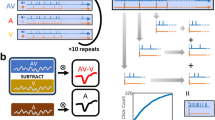Summary
Marked alterations in the wave forms of the visual evoked potential were found during repeated observations in 7 unrestrained cats. These changes were usually, but not always, associated with behavioral and electroencephalographic correlates of sleep and wakefulness.
The different evoked potentials could be characterized as belonging to one of 8 possible wave forms. All wave forms were obtained from each cat although the frequency of occurrence of different wave forms varied between cats.
During alert behavior the most common wave form consisted of two rapid, diphasic peaks, starting at about 20 msec with a positive wave following the flash. A more rhythmic wave form of six diphasic peaks was also common during the alert state.
With increasing behavioral drowsiness and sleep spindles the wave form usually showed an increase in amplitude of negative waves.
At times a wave form was present in which the early waves were missing. This wave form consisted only of two late, low-amplitude, diphasic waves and was always associated with a desynchronized EEG. Usually the animal was in activated sleep (r.e.m.-sleep) when this form of the evoked potential was observed.
The observed variations in the form of the evoked potential may result from peripheral delays and activation of different pathways to different cortical neuron groups. Alternatively, the wave forms may be produced by alterations in latency of the second of two oscillating pathways to the cortex.
Similar content being viewed by others
References
Brazier, M. A. B.: A study of the late response to flash in the cortex of the cat. Acta physiol. pharmacol. neerl. 6, 692–714 (1957).
—— The electrophysiological effects of barbiturates on the brain. In: Root, W.S. and F. C. Hofmann (Eds.): Physiological Pharmacology, pp. 219–238. New York: Academic Press 1963.
Černáček, J., and L. Cigánek: The cortical electroencephalographic response to light stimulation in epilepsy. Epilepsia (Boston) 3, 303–314 (1962).
Chang, H.-T.: The repetitive discharges of cortico thalamic reverberating circuit. J. Neurophysiol. 13, 235–257 (1950).
Cigánek, L.: The EEG response (evoked potential) to light in man. Electroenceph. clin. Neurophysiol. 13, 165–172 (1961).
Cohn, R.: Rhythmic after-activity in visual evoked responses. Ann. N. Y. Acad. Sci. 112, 281–291 (1964).
Dagnino, N., E. Favale, C. Loeb, and M. Manfredi: Sensory transmission in the geniculostriate system of the cat during natural sleep and arousal. J. Neurophysiol. 28, 443–456 (1965).
Dawson, G. D.: Central responses to electrical stimulation of peripheral nerve in man. J. Neurol. Neurosurg. Psychiat. 10, 137–140 (1947).
Dement, W., and N. Kleitman: Cyclic variations in EEG during sleep and their relation to eye movements, body motility and dreaming. Electroenceph. clin. Neurophysiol. 9, 673–690 (1957).
Dunlop, C. W., W. R. Webster, and L. A. Simons: Effect of attention on evoked response in the classical auditory pathway. Nature (Lond.) 206, 1048–1050 (1965).
Ebe, M., T. Mikami, and H. Ito: Cortical evoked potentials by photic stimulation at various adaptation levels of retina in man. Tohoku J. exp. Med. 80, 9–17 (1963).
Forbes, A., and B. R. Morison: Cortical response to sensory stimulation under deep barbiturate narcosis. J. Neurophysiol. 2, 112–128 (1936).
García-Austt, E.: Influence of the states of awareness upon sensory evoked potentials. Electroenceph. clin. Neurophysiol., Suppl. 24, 76–89 (1963).
Hernández-Peón, R., C. Guzmán-Flores, M. Alcaraz, and Fernández-Guardiola: Sensory transmission in visual pathway during “attention” in unanesthetized cats. Acta neurol. lat.-amer. 3, 1–8 (1957).
——, and H. Scherrer: Auditory potential at cochlear nucleus during acoustic habituation. Acta neurol. lat.-amer. 3, 144–156 (1957).
Hirsch, J. F., B. Pertuiset, J. Calvet, J. Buisson-Ferey, H. Fischgold, and J. Scherrer: Etude des résponses électrocorticales obtenues chez l'homme par des stimulations somesthésique et visuelles. Electroenceph. clin. Neurophysiol. 13, 411–424 (1961).
Homer, L. D., and H. Kolder: Mathematical model of oscillations in the human corneo-retinal potential. Pflügers Arch. ges. Physiol. 287, 197–202 (1966).
Jane, J. A., G. D. Smirnov, and H. H. Jasper: Effects of distraction upon simultaneous auditory and visual evoked potentials. Electroenceph. clin. Neurophysiol. 14, 344–358 (1962).
Norton, S., and R. E. Jewett: A pyrrolopyrimidine with depressant actions on the CNS. J. Pharmacol. exp. Ther. 154, 152 (1966).
Rose, G. H., and D. B. Lindsley: Visually evoked electrocortical responses in kittens: development of specific and non specific systems. Science 148, 1244–1246 (1965).
Starr, A.: Influence of motor activity on click-evoked responses in the auditory pathway of waking cats. Exp. Neurol. 10, 191–204 (1964).
Steinberg, R. H.: Alterations of averaged photic evoked potentials in cat visual cortex during repetitive stimulation. Electroenceph. clin. Neurophysiol. 18, 378–391 (1965).
Winters, W. D.: Comparison of the average cortical and subcortical evoked response to clicks during various stages of wakefulness, slow wave sleep and rhombencephalic sleep. Electroenceph. clin. Neurophysiol. 17, 234–245 (1964).
Author information
Authors and Affiliations
Additional information
Presented in part to the Federation of American Societies for Experimental Biology in Atlantic City, New Jersey, April, 1966.
Supported by research grant MH 07278 from the National Institute of Mental Health, U.S. Public Health Service.
Special Fellow 2F11 NB 1210, National Institute of Neurological Diseases and Blindness. Present address: Emory University, Atlanta, Georgia.
Rights and permissions
About this article
Cite this article
Norton, S., Jewett, R.E. An analysis of visual evoked potential wave forms in unrestrained cats. Pflugers Arch. 294, 17–27 (1967). https://doi.org/10.1007/BF00417048
Received:
Issue Date:
DOI: https://doi.org/10.1007/BF00417048



